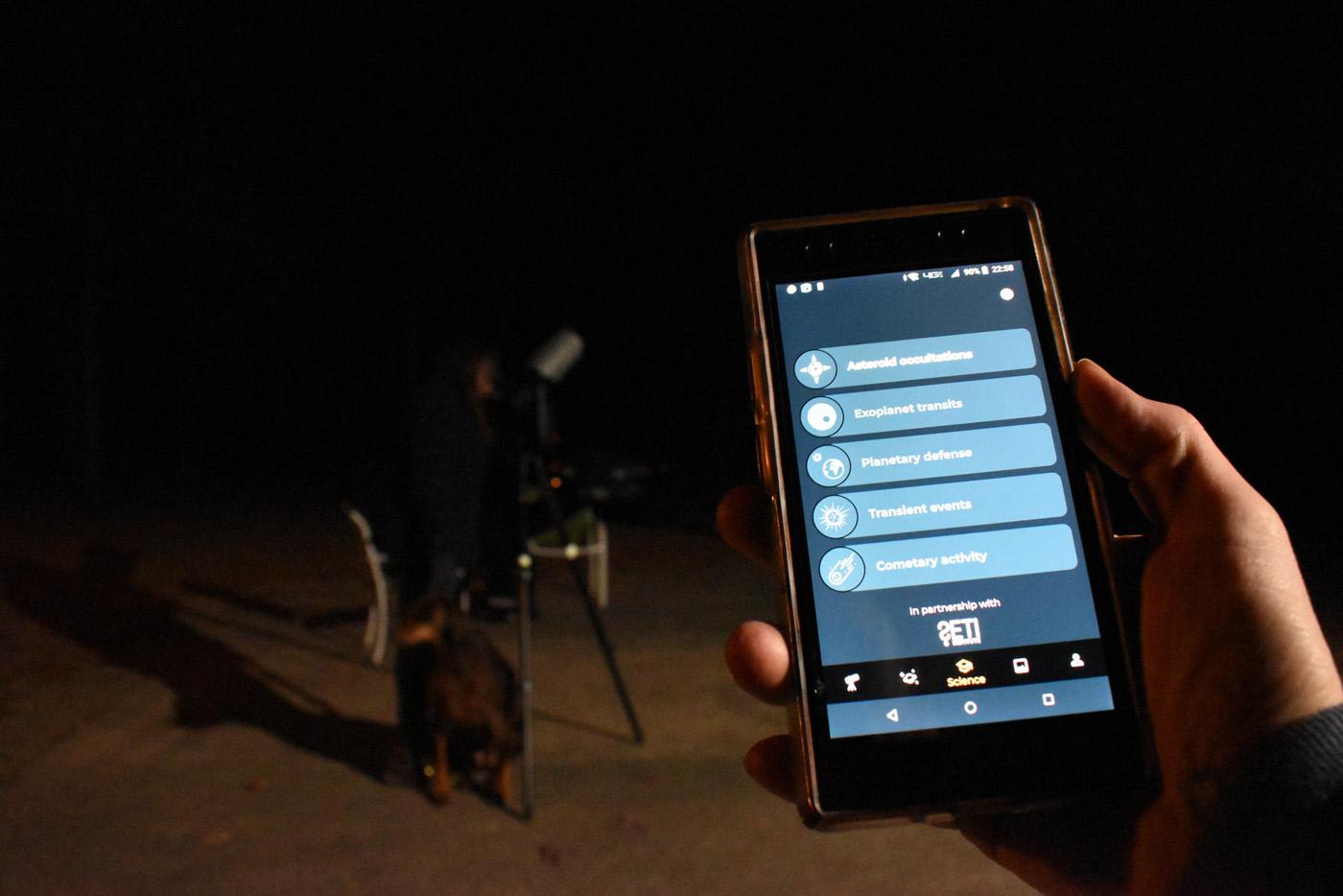
October 29, 2020 – Marseille, France and Mountain View, CA: There are nearly one million catalogued asteroids, but we don’t know much about many of them. Now Unistellar and its scientific partner, the SETI Institute, can count on a network of nearly 3,000 amateurs capable of observing thousands of asteroids and providing an estimate of their size and shape. With mobile stations located in Asia, North America and Europe, the Unistellar network, the largest network of citizen astronomers, participates in cutting-edge research and has delivered its first scientific results including the 3D shape model of an asteroid and the size of another one.
“The Unistellar eVscope is more than a telescope. It’s also a tool to access a network made of citizen astronomers throughout the world who can observe together and participate in scientific campaigns,” said Franck Marchis, senior planetary astronomer at the SETI Institute and Chief Scientific Officer at Unistellar. “Today more than 150 people have already contributed to our campaigns and collected valuable scientific data from their backyard.”
In addition to the SETI Institute, Marchis’ group collaborated with Josef Hanuš and Josef Ďurech of the Institute of Astronomy at Charles University to identify potential targets of interest in the asteroid population. “After having designed and validated our data analysis pipeline in 2020, we can now routinely propose campaigns to our citizen astronomers,” said Marchis.
Asteroid 943 Begonia: An Occultation Event
Although it was discovered in October of 1920, we don’t know much about asteroid 943 Begonia’s size. Inès Demuys, Unistellar Engineer, identified an occultation event by Begonia. An occultation is when a star temporarily disappears when an asteroid (or something else) passes in front of it. Two U.S.-based citizen astronomers, based in Arizona and in New York, detected the occultation with their eVscopes (Unistellar’s digital telescope) in September of 2020. Analysis of the data they collected revealed that the main-belt asteroid could have a diameter of 83 km, making it 20% larger than previously known.
“The main difficulty of these kinds of observations is to be located in the right place and to observe at the right time,” said Marchis. “Timing, good weather and a little luck are necessary. Fifty-three occultations campaigns were launched, leading to 10 positive detections, but as the process matures in the coming weeks, positive detections will indeed happen more often. Combined with an increasing number of observers we thus expect a growing number of evermore accurate scientific results.

Asteroid 787 Moskva: Lightcurve Inversion
Another way to study asteroids is to measure the variation of light reflected due to their irregular shape. “Despite its relatively small aperture size, the eVscope is powerful enough to characterize around ~6,000 known asteroids in a year. SETI Institute Research Assistant Joé Asencio selected the main-belt asteroid 787 Moskva, which has an estimated diameter of 30 km. We asked our network to observe it for more than one hour in August 2020, and 7 citizen astronomers from 4 different countries, USA, Finland, Switzerland, and France sent their observations,” said Tom Esposito, an astronomer at the SETI Institute and UC Berkeley.
The flux variation over time, also called a lightcurve, showed the asteroid’s spin and confirmed a spin period of 6.056 hours. Combining these new observations with previous ones, the team at Charles University found a new shape model of the asteroid, which is quite elongated and has a diameter between 25-30 km.
“This observation validates the use of the eVscope for accurate photometric studies, including transiting exoplanets, variable stars, supernovae and other transient events, significantly increasing the number of investigations possible with the Unistellar network,” said Esposito.
Motivated by these recent results, the team is adding a new program in education and increasing the eVscope’s network. “Education is one of the cornerstones of the SETI Institute’s work and philosophy” says Simon Steel, Senior Director of Education and STEM Programs at the SETI Institute. “Unistellar technology is a powerful tool to engage and excite the next generation of astronomers, scientists and indeed anyone who has ever pondered the beauty of the night sky.”
Science team members at the SETI Institute and Unistellar include Joé Asencio, Guillaume Blaclard, Inès Demuys, Christian Everett, Val Klavans, Dan Peluso, Thomas Esposito, and Franck Marchis. Citizen astronomers who participated in these campaigns include Richard Born, Brad Davis, Bruno Guillet, Rachel Knight, Julien de Lambilly, Matthieu Lauvernier, Bruce Parker, Sam Rihani, Petri Tikkanen.
These findings will be presented at the 52nd Annual Meeting of the Division of Planetary Sciences of the American Astronomical Society:
Session 413 Education and Community Engagement 2 Presentation. 413.02 First Results With a Network of Small Digital & Smart Telescopes: Citizen Science For Astronomy by Franck Marchis, SETI Institute & Unistellar on Thursday October 29.
A press briefing will be held on Thursday, October 29 at 10:45 AM EDT with Thomas Esposito.
Unistellar asteroid program including selected occultation events and lightcurve request is here:
https://unistellaroptics.com/asteroid-program/
Proceeding paper published as an IAC proceeding available here:
https://app.box.com/s/xsaovkwtgrtkulfudlul36oaojx99lgd
DOWNLOAD FULL PRESS RELEASE HERE.
Press Materials:
The Unistellar App and its Science Menu:
https://app.box.com/s/hlrqcs4a21qzhxdd4z0eauom4s9lzxf7
Map to the Unistellar Users:
https://app.box.com/s/t2ns2zlampqoq2z28x4vn1yeo11ftlgf
Profile of Begonia:
https://app.box.com/s/3ljde6hd6ucok6eyjg8tpaovpaundtvd
3D shape model of Moskva:
https://app.box.com/s/ywa16e2c0udl1hbvr9l8jds17w17m0ai
Picture of a 3D-print of Moskva:
https://app.box.com/s/me6chl742p3fovk8u3udvxvu6uz094qw
About the SETI Institute
Founded in 1984, the SETI Institute is a non-profit, multi-disciplinary research and education organization whose mission is to lead humanity’s quest to understand the origins and prevalence of life and intelligence in the Universe and to share that knowledge with the world. Our research encompasses the physical and biological sciences and leverages expertise in data analytics, machine learning and advanced signal detection technologies. The SETI Institute is a distinguished research partner for industry, academia and government agencies, including NASA and NSF.
Contact information
Rebecca McDonald,
Director of Communications SETI Institute
189 Bernardo Ave., Suite 200
Mountain View, CA 94043
rmcdonald@seti.org
media@seti.org





